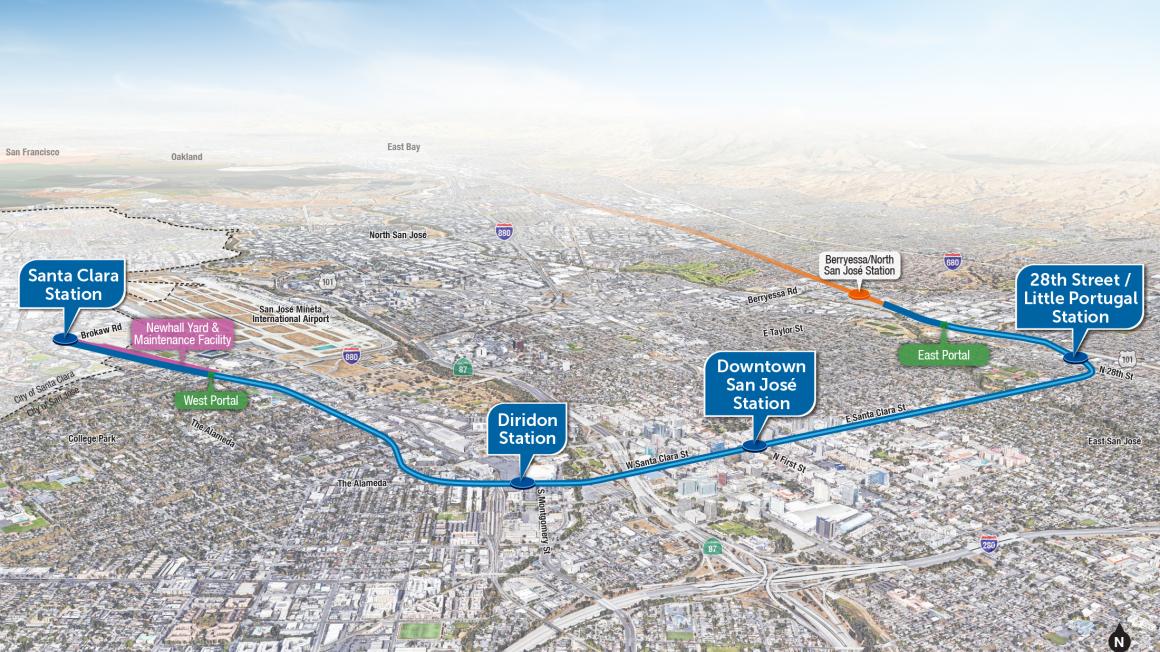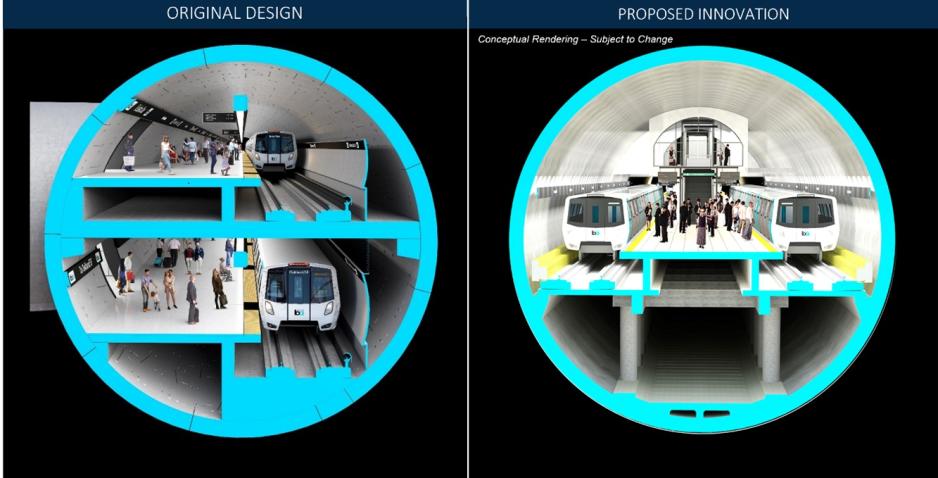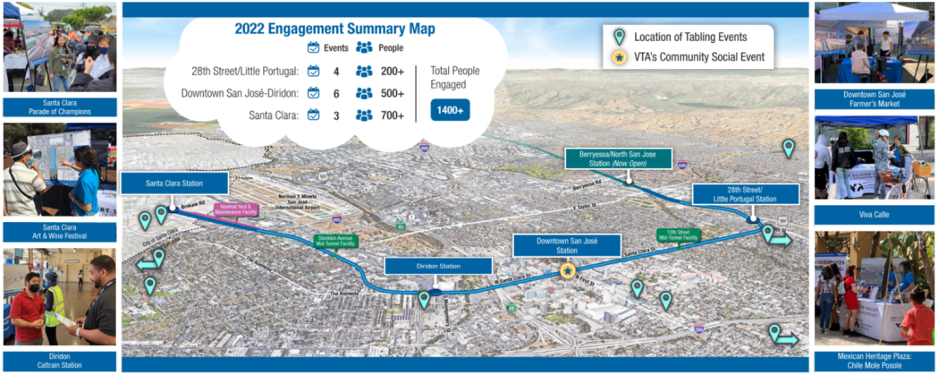Project Overview
VTA’s BART Silicon Valley Phase II Extension Project (The Phase II Project) is a six-mile, four-station extension of the regional BART system from the Berryessa/North San José Station (opened in 2020) through downtown San José to the City of Santa Clara. The Phase II Project is planned to include an approximately five-mile subway tunnel, three stations with underground platforms (28th Street/Little Portugal, Downtown San José, and Diridon), one ground-level station (Santa Clara), a train maintenance and storage facility, and additional facilities.
The Phase II Project is estimated to carry 54,600 passengers each weekday to destinations throughout the Bay Area by 2040. This alternative mode of transportation will allow passengers to benefit from faster, more efficient travel throughout the Bay Area while the region simultaneously benefits from reduced traffic congestion and greenhouse gas emissions
Tunnel and Trackwork Proposed Innovations
Intro
Kiewit Shea Traylor Joint Venture (KSTJV) was awarded a contract for the Phase II Project’s tunnel and trackwork, Contract Package 2 (CP2) at the May 5th VTA Board of Directors meeting. Since then, there have been multiple exciting developments as VTA has collaborated with the contractor and other stakeholders to evaluate and further refine tunnel and trackwork innovations.
During the 90-day innovation period, VTA worked closely with BART to review the 38 proposed innovations and identify 16 for further advancement and evaluation. Since first presenting at the September VTA Board of Directors meeting, VTA and BART staff have continued to coordinate with KSTJV to further refine and evaluate the proposed innovations.
A couple key proposed innovations are described below:
Tunnel Innovations: Side-by-Side Underground Track Layout
The first (and most significant) proposed innovation is for a larger diameter single bore tunnel, which would increase the internal tunnel diameter from approximately 43 feet to 48 feet. The larger tunnel would accommodate a side-by-side track layout with center platforms, moving away from the original design with stacked platforms and tracks at two of the stations.
Tunnel Innovation Benefits
Constructability
The increased tunnel diameter provides the opportunity for a consistent track configuration and would decrease construction costs for this project element due to the less-complicated structures with this track layout. The proposed innovation is also anticipated to decrease the construction duration and facilitate the construction of safety passages (known as cross-passages) throughout the tunnel.
Operations
A side-by-side layout allows for greater operational flexibility, making it easier for trains to switch from one track to the other for maintenance, scheduled downtime, or emergencies. The simplified interior structures and trackwork also allow for easier maintenance, which would provide long-term cost savings throughout the life of this project.
Passenger Experience
Passenger circulation within the stations will also be improved as a side-by-side track configuration is utilized throughout the BART system.
Ventilation Improvements
Because of the reconfiguration of the track layout and larger sized tunnel, there is more space to accommodate emergency ventilation and allows for the major facilities to be consolidated, which may provide the opportunity to remove mid-tunnel ventilation facilities that were part of the original design. This setup is more cost-effective, easier to maintain, reduces the duration of construction, and improves security by reducing the number of access points to the system.
28th Street/Little Portugal
VTA also identified innovations specific to the 28th Street/Little Portugal Station, including alternative excavation options that would significantly decrease the area affected. The smaller station footprint and decreased excavation will lessen construction impacts to the community and reduce duration of construction.
Station Refinement
VTA is one step closer to delivering BART service to four new stations in Silicon Valley following a phase of robust stakeholder collaboration. As a result of recent efforts with local partners and Project contractors, VTA is analyzing potential refinements to three station designs as well as improvements to tunneling and trackwork methods that will lead to a better overall Project.
Following direction from the VTA Board of Directors in early summer of 2022, VTA’s BART Silicon Valley Phase II staff held a series of workshops to review the designs of Downtown San José and Diridon BART Stations. Central to this effort was a task force of public and private transportation professionals charged with identifying and evaluating potential station design refinements to enhance connectivity and access, passenger experience and circulation, and optimize on-site, high-density transit-oriented development (TOD) at both stations. Project staff worked closely with local partners to develop several refinement concepts with varying configurations. This effort culminated with task force members collaboratively evaluating and advancing refinement concepts for further consideration by Project staff and the VTA Board of Directors. The Project’s architecture and engineering teams are currently in the process of determining costs and feasibilities of preferred concepts. Once completed, project staff will provide a summary and recommend next steps to the VTA Board of Directors.
The station design refinement effort was conducted in parallel with the KSTJV innovation period. The refinements being considered as part of this effort are in addition to and independent from those proposed by the contractor.
Peer Exchange Review
On November 3rd results of the Peer Exchange Review study on tunneling methodology (led by the American Public Transportation Association (APTA)) were presented at the VTA Board of Directors Meeting. The results confirmed that the single-bore tunneling approach is indeed the most feasible, appropriate, safe, and efficient approach moving forward. The tunneling method of this project will “save construction time, reduce the station footprint and property needs, increase the potential for transit-oriented development, reduce disruption to city streets, neighborhoods, and businesses. The approach reduces many of the environmental impacts occurring during construction.”
Community Engagement
In-Person Events in 2022
Since June of this year the team has participated in 14 public engagement events (including a Community Social) that has allowed the project team the opportunity to connect, inform, and gather input from more than 1,400 community members along the project alignment. Our latest tabling events included the Alum Rock Farmer’s Market, Downtown San Jose Farmer’s Market, and the Santa Clara Parade of Champions.
A big thank you to those of you that stopped by our booth to share your comments and feedback. The team plans to continue participating in many more community events and hopes to see you there! As we prepare to close the year and look to plan events for the following year it would be helpful to gather your feedback on which events to attend.
Please let us know where you would like see us participate next!
Online Engagement
Website Refresh
- Station factsheets have been updated and are also available in Spanish, Vietnamese, Chinese, Korean, Tagalog, and Portuguese!
Upcoming Events
- VTA Board of Directors Meeting
- Thursday December 1, 2022
- Upcoming Community Working Group Meetings
- Tuesday February 14, 2023 – Downtown-Diridon
- Wednesday February 15, 2023 – 28th Street/Little Portugal
- Thursday February 16, 2023 – Santa Clara
Wishing you all a Joyful Holiday Season!


